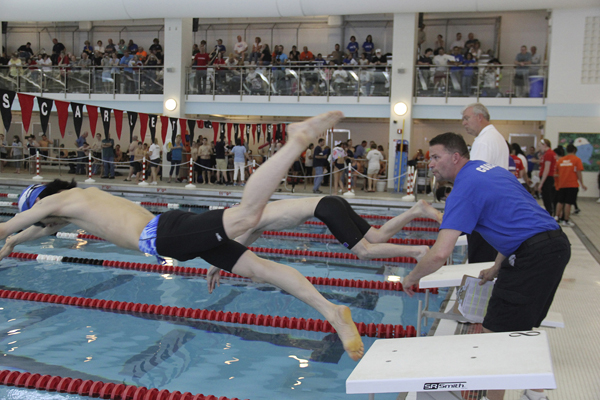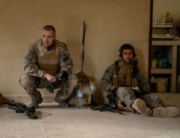
Kelvin Truong dives into the pool as coach Mike McQuay gives encouragement in Swim Team (Argot Pictures)
There are common expectations for behaviors and limitations that accompany being labeled as autistic. A definition might include poor communication skills, lack of eye contact, limited mental capacity, and resistance to instruction, among others. Those diagnosed with autism often live beneath an umbrella of ubiquitous assumptions that deny their individualism. The mother of an autistic child, director Lara Stolman sensitively and effectively portrays the very different personalities of three autistic young men and their potential for achievement.
Her documentary takes place in Perth Amboy, New Jersey. According to the film, the state has the highest rate of autism in the country, with one in every 26 boys affected. Mike and Maria McQuay were repeatedly discouraged by the lack of programs and activities open to their son, Mikey, as he approached high school graduation. He was isolated from his peers by his disability and had few prospects for his future. Mike and Maria were determined to create an opportunity for social interaction and confidence building that would also serve to save lives. The number one cause of death among autistic kids is drowning. The McQuays secured help from the local YMCA, which donated the use of its pool, for the formation of a Special Olympics–bound swim team for autistic teens and young adults.
Stolman focuses on the Jersey Hammerhead’s three top swimmers. Mike is a natural athlete and an animal lover. He knows he’s different, but in the water he feels himself connected to dolphins, whales, and fish. Robbie wants to be the second Michael Phelps. He’s a member of his high school swim team as well as the Hammerheads. Goal oriented and determined, he’s unaware of his diagnosis. Kelvin, besides being autistic, has Tourette’s syndrome. Frustrated by his constant tics and fits of anger, he finds relief when he swims. Despite their individual challenges, these three young men learn how to set the example for the other swimmers and help lead their team through a competitive season of swim meets.
Each of the boy’s parents emotionally recall receiving the devastating diagnosis and how they were told their children would never talk or be able to dress themselves. They discuss the sacrifices, the frustrations, and mostly of their commitment to do whatever it takes to help their sons become more self-sufficient. Mike, as the team’s coach, expertly balances his understanding of each boy’s behavioral issues with the necessary demands for effort and commitment that it takes to become a winning team. Mike’s emotional stake in the team is evident when one swimmer’s mistake costs a win, or when a parent’s late arrival risks the Hammerheads’ disqualification from an important meet.
The swim meets are, as expected, exciting events, made more so by an understanding of the trio’s personal situations. It is impossible not to root for them. Perhaps the most effective moments are the underwater shots. Cinematographer Laela Kilbourn beautifully captures the unlikely combination of tension and grace in each of the young men’s swimming techniques. Robbie’s mastery of the butterfly is particularly beautiful to watch. Kilbourn’s underwater footage of Kelvin’s smooth swimming style is in sharp contrast to the uncontrolled movements and tics above the surface. Composer Mark Suozzo’s score provides an empathetic sense of the peace and freedom that Kelvin seems to experience as he swims.
For parents of children with autism, and particularly for those who have only recently received a diagnosis, this film provides a beacon of hope. Mikey, Robbie, and Kelvin have far exceeded expectations and continue to show promise for attaining a level of self-sufficiency. For viewers who have not experienced autism firsthand, it will be nearly impossible to walk away from this film without a deeper level of understanding and acceptance.
















Leave A Comment